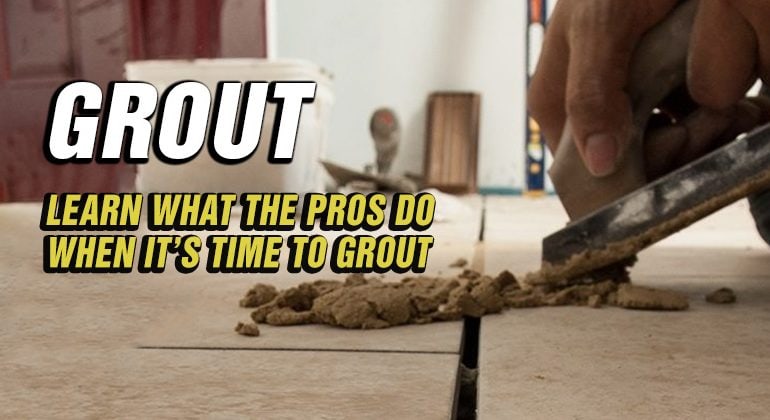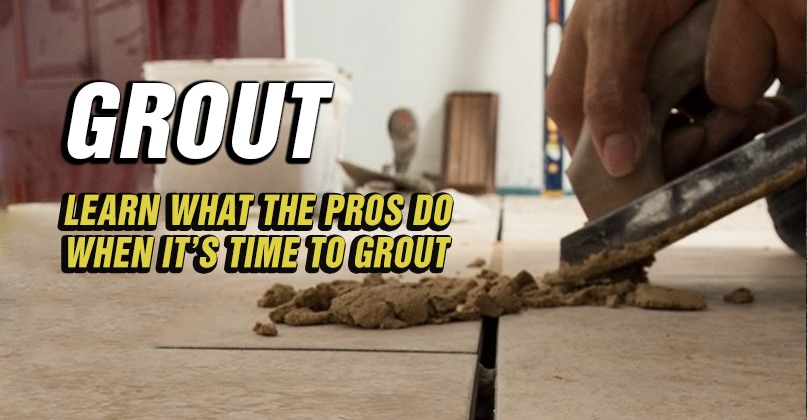Dream of a career where your skills bring joy, enable freedom, and create unforgettable memories? The thriving recreational vehicle (RV) industry offers just that! It’s more than fixing vehicles; it’s...

When It’s Time To Grout
By Mike Holmes
Mike’s Advice / Bathroom Renovation
Friday, November 6th, 2020 @ 8:00am
There are many different types of grout and it’s important that the right one is used for the type of tile that’s being installed, whether it’s for a backsplash, kitchen floor, bathroom, shower or fireplace. An expert opinion never hurts.
What type of grout to pick?
There are two kinds of cement-based grout, sanded and unsanded.
Sanded Grout
Sanded grout is commonly used for kitchen floors, using a grout space between 1/8” to 3/8” plus it has added sand for extra durability and reduces shrinkage and crack lines.
RELATED
For more information on kitchen floor tiles check out The Top 5 Benefits of Floor Tiles.
Unsanded Grout
Unsanded grout is typically used for kitchen backsplashes with a narrow grout line (no bigger than 1/8”) and is more expensive. If used in larger grout joints, a non-sanded grout may crack due too shrinkage and lack of sand in the mixture.
RELATED
Check out Sherry’s 25 Kitchen Backsplash Ideas!
Epoxy Grout
There is also epoxy grout, which is made of epoxy resins and filler powder.
Epoxy grouts are durable and resistant to stains and water damage. Epoxy grout is a good choice for bathroom installations and kitchen backsplashes. However, these grouts can yellow or fade on exterior applications. Be sure to check with your specific grout manufacturer about outdoor use. Be careful using epoxy grout as you need to work quickly before it starts to set and become hard, so work in small batches. This also means that you should hire a Pro as there is little room for mistakes. This type of grout doesn’t require a sealer.
Single Component Grout
Single component grout is a urethane or acrylic-silicone resin grout. Single component grout comes premixed in a bucket with a re-sealable lid, meaning you can save it and use it remaining grout another time.
This type of grout has many benefits, as it provides colour consistency, doesn’t require a sealer, resistant to breakage and chemicals, mold and mildew, is stain resistant, and doesn’t effloresce.
What colour of grout do you choose?
There are many options, and it can be overwhelming, especially if you want to do something fun or create an impact. Darker grouts will hide dirt and stains but are also prone to fading. Darker grout can stain lighter tile or tiles with a texture, so be sure to do a test first. At the same time, lighter grout can show stains, and it is harder to keep clean. It comes down to personal preference. Just be aware you have choices to enhance your design.
There are 3 ways to choose what colour of grout to use.
#1. Matching – chose a grout colour that matches or is very close to the colour of your tiles. This allows the tiles to stand out and keeps a monochromatic scheme.

When the tile and grout colour match a monochromatic look is achieved from Holmes Makes it Right.
#2. Contrasting – this is when you chose a grout colour that contrasts with your tiles. Using a dark charcoal grout with white or lighter tiles is very popular today and allows the shape of the tiles stand out and is especially effective if you are using geometric shaped tiles.

Contrasting grout lines with dark tile provide impact in this elegant bathroom by Rinaldi Homes.
#3. Neutral – neutral grout is always a safe bet as it goes with everything. The tile pattern will be more noticeable than using matching grout but will not provide the impact when using contrasting grout.

A neutral grout line allows the beauty of these tiles to shine, from Duvanco Homes.
Some grouts have sealants in them, some don’t; some are sanded, some aren’t; and they come in different colours, too. (Try to stay away from whites and lighter colours because they will get dirtier, faster!)
Then there’s ready-mix grout that comes in a pale or the powder kind that requires water. Every grout has its own set of rules and instructions, and they must be followed to a tee. But a general rule of thumb is that grout should be the consistency of peanut butter.
To Seal Or Not To Seal
Grout is porous so that it will absorb vapour and moisture. To prevent moisture from being trapped behind the grout and tiles, which can lead to mould and rot, the grout needs to breathe.
If the grout comes with a sealant or the homeowner insists the grout be sealed to prevent stains or dirt, it is crucial to make sure the sealant is breathable.
For more information on grout, tiling and renovations check out these blogs:
Do’s and Don’ts Bathroom Renos
READ NEXT








